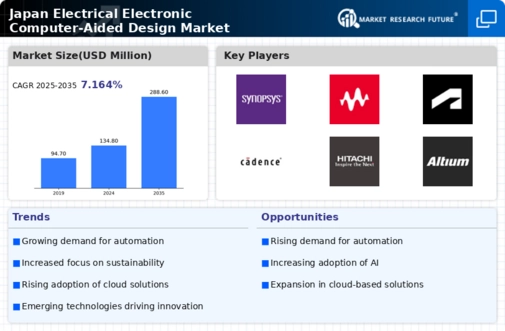The electrical electronic computer aided design market in Japan is characterized by a dynamic competitive landscape, driven by rapid technological advancements and increasing demand for sophisticated design tools. Key players such as Cadence Design Systems (JP), Synopsys (JP), and Mentor Graphics (JP) are at the forefront, each adopting distinct strategies to enhance their market positioning. Cadence Design Systems (JP) focuses on innovation through continuous investment in research and development, aiming to integrate AI capabilities into their design tools. Meanwhile, Synopsys (JP) emphasizes strategic partnerships, collaborating with various semiconductor manufacturers to optimize their design solutions. Mentor Graphics (JP), on the other hand, has been actively pursuing mergers and acquisitions to expand its product offerings and market reach, thereby intensifying competition within the sector.
The business tactics employed by these companies reflect a concerted effort to localize manufacturing and optimize supply chains, which are crucial in a moderately fragmented market. This competitive structure allows for a diverse range of offerings, yet the influence of major players remains substantial. The collective strategies of these companies not only shape their individual trajectories but also contribute to a more robust and competitive environment, where innovation and efficiency are paramount.
In November 2025, Cadence Design Systems (JP) announced a strategic partnership with a leading AI firm to enhance its design automation tools. This collaboration is expected to leverage machine learning algorithms to streamline the design process, potentially reducing time-to-market for new products. Such a move underscores Cadence's commitment to remaining at the cutting edge of technology, positioning itself as a leader in the integration of AI within design workflows.
In October 2025, Synopsys (JP) launched a new suite of tools aimed at improving the efficiency of electronic design automation (EDA) processes. This initiative is particularly significant as it addresses the growing complexity of modern electronic systems, suggesting that Synopsys is keen on maintaining its competitive edge by offering solutions that meet the evolving needs of its clients. The introduction of these tools may enhance customer loyalty and attract new clients seeking advanced design capabilities.
In September 2025, Mentor Graphics (JP) completed the acquisition of a smaller EDA company, which specializes in cloud-based design solutions. This acquisition is indicative of Mentor's strategy to diversify its offerings and tap into the growing demand for cloud-based services in the design sector. By integrating these capabilities, Mentor Graphics (JP) aims to provide a more comprehensive suite of tools, thereby enhancing its competitive position in the market.
As of December 2025, the competitive trends within the electrical electronic computer aided design market are increasingly defined by digitalization, sustainability, and the integration of AI technologies. Strategic alliances are becoming more prevalent, as companies recognize the need to collaborate in order to innovate effectively. Looking ahead, it appears that competitive differentiation will increasingly hinge on innovation and technological advancements rather than solely on price. The emphasis on supply chain reliability and the ability to adapt to market changes will likely become critical factors in determining success in this evolving landscape.


















Leave a Comment